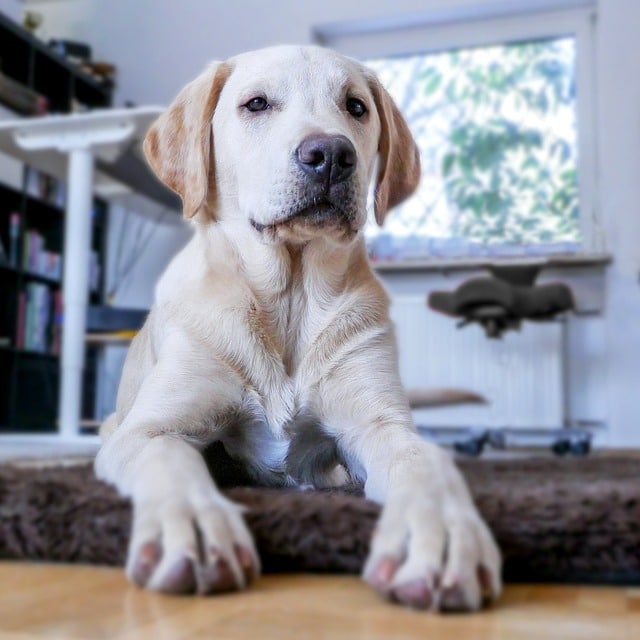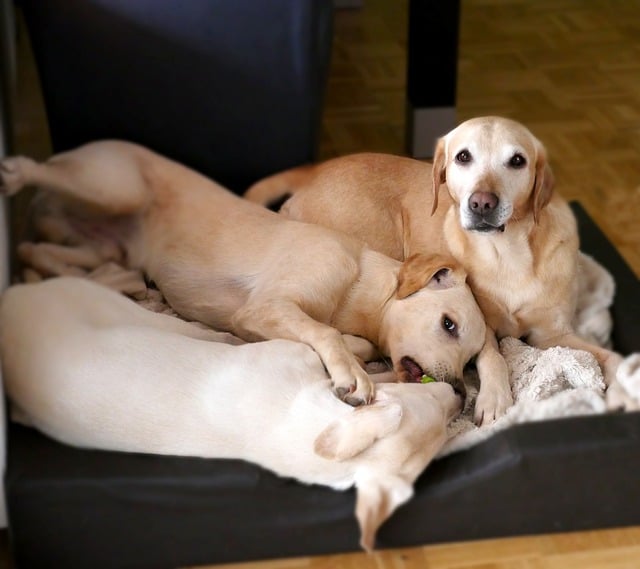Have you ever wondered how to get rid of dog pee smell?
Dogs make excellent companions, but sometimes their accidents can leave a not-so-pleasant odor behind. The truth is no matter how well-trained your furry friend is, accidents happen, and if you don’t act quickly, the odor can linger for a long time. Fortunately, there are several ways to remove the pungent smell of dog urine from your carpets and other surfaces. In this blog post, we’ll show you some of the most effective methods to get rid of dog pee smell.
Use a Mixture of Water and Vinegar
White vinegar is an excellent natural cleaner that can effectively neutralize the smell of dog urine. For general messes, mix equal parts water and vinegar in a spray bottle and apply it to the affected area. Allow the solution to soak in for at least ten minutes before blotting the area with paper towels. This is good to use on dog beds as it’s a natural cleaner. You can repeat this process as necessary until the odor disappears.
Try Baking Soda
For more stubborn dog urine odors, sprinkle baking soda over the affected area and let the baking soda sit overnight. The baking soda will absorb any remaining moisture from the urine stain and neutralize unpleasant smells. In the morning, you can vacuum up the baking soda, and your carpet or rug will smell fresh and clean. Repeat the process if necessary.
Use Enzymatic Cleaners
Enzymatic cleaner is specially designed to remove pet urine stains and odors. These cleaners contain enzymes that break down the proteins in pet urine, eliminating the source of the smell. Be sure to use a paper towel to completely soak up the urine before spraying the cleaner. You can find enzymatic cleaners at your local pet store or online. Follow the instructions on the label, and your home will be free from the smell of dog urine.
Steam Cleaning
Steam cleaning is an excellent option for removing dog urine smells and pet stains from carpets and upholstery. You can buy or rent a steam cleaner from a home improvement store or equipment rental company. The high-temperature steam will kill bacteria and eliminate odors. Be sure to read and follow the instructions carefully to avoid damaging your carpets or furniture.
Hire a Professional
If you’ve tried all of these methods and still can’t get rid of the dog pee smell, it might be time to bring in the professionals. Professional cleaning companies have equipment and cleaning solutions that can effectively eliminate pet urine odors. You may also want to hire an odor control expert if the the urine smell has penetrated the subfloor or walls.

How to Get Your Dog to Stop Peeing in the House
Dog owners know the struggle of keeping their furry friend’s behavior in line. If your dog is repeatedly peeing inside the house, it can be frustrating, unpleasant, and embarrassing. But don’t despair – Below, you will learn some tips on how to stop your dog from peeing inside the house and regain your peace of mind.
Train Your Dog
Potty training should start from the moment your dog comes home. It’s important to establish a routine for your dog, including scheduled times for feeding, exercising, and potty breaks. Consistency is the key to success, so stick to the routine. Keep track of when your dog has accidents and adjust your schedule accordingly. Use positive reinforcement techniques, such as treats and verbal praise when your dog correctly goes outside. Consider crate training for puppies or dogs who need additional assistance in understanding your expectations.
Make the Environment Less Appealing
Dogs may pee indoors because they find the scent or texture of the surface pleasing. So, make sure you clean the area thoroughly with an enzyme-based cleaner. Also, avoid using ammonia-based products, as they can smell like dog urine smell and may entice the dog to urinate again. Additionally, restrict your dog’s access to areas they are prone to urinate or mark. Keep your doors closed or use baby gates to limit your dog’s movement to certain areas.
Monitor Your Dog’s Diet
Your dog’s diet plays a crucial role in their urinary habits. Overfeeding your dog or letting them eat or drink before bedtime can increase the likelihood of accidents. So, monitor their eating and drinking habits and schedule their meals and water breaks at regular intervals. If you’re unsure about the appropriate portion size for your dog, ask your vet for advice.
Be Patient and Consistent
Correcting this behavior is not something that will happen overnight. It will take some time, and accidents will happen along the way. However, it’s essential to remain patient and consistent with your training methods. Yelling or punishing your dog for accidents can only make things worse – positive reinforcement is the best approach.
Seek The Help of a Professional
If your dog’s accidents persist, it might be time to seek the help of a professional. A vet, animal behaviorist, or dog trainer can help tailor a program to your dog’s specific needs and modify their behavior. Don’t hesitate to ask for help when you need it.
Accidents are an inevitable part of dog training, but with patience, consistency, and positive reinforcement, you can make a significant difference. Remember that your dog’s behavior is a reflection of your efforts to train and socialize them. With appropriate training, the right diet, and consistency, you can help your dog learn to pee outside and eliminate indoor accidents once and for all.

Why Do Dogs Pee in the House?
Dogs are undoubtedly some of the most loyal and loving companions anyone could ask for. Their playful nature and unwavering affection never cease to bring a smile to our faces. However, sometimes even the most well-trained and obedient dogs will pee in the house, which can be exasperating for any pet owner. This behavior can often be confusing and frustrating for pet owners. Keep reading and we’ll explore some of the reasons why dogs might exhibit this behavior and what you can do to prevent it from happening.
Medical Issues
The first thing you should always consider when your dog starts peeing in the house is medical issues. Diabetes, bladder infections, and other health problems could all be causing your furry friend to eliminate inside the house. If you suspect your dog has an underlying condition, it’s essential to take them to the vet for an examination and proper diagnosis. In many cases, treating the underlying issue can solve the peeing problem.
Age and Urinary Tract
Dogs that are aging gradually begin to lose control over their bladder and bowels, which makes it challenging for them to hold urine for an extended period. Urinary tract infections are also a common problem among older dogs, leading to frequent urination. It’s essential to maintain consistent potty breaks for dogs that are aging to avoid them having to eliminate in the house.
Anxiety and Stress
Dogs are emotional beings, and anxiety or stress can often lead to behavioral changes. Separation anxiety is one of the most common causes of peeing in the house among dogs. Being a social animal, dogs love to be around their family, and when left alone for extended periods, they could get anxious, leading to behavioral changes like peeing in the house. In such cases, it’s necessary to train your dog to be independent and to gradually increase their time spent alone.
Territorial and Marking Behaviors
Dogs often use urine to mark their territory or send messages to other dogs. Male dogs, in particular, exhibit territorial behavior more often. In such cases, dogs could be peeing in the house to secure their “territory.” It’s essential to train your dog to recognize and respect boundaries to prevent such behavior. Moreover, having a consistent potty routine and rewarding good outdoor behavior should help to curb territorial and marking behavior.
Lack of Potty Training
Lastly, and most importantly, in most cases, the reason why dogs pee in the house is due to a lack of potty training. New puppies or newly adopted dogs might not understand that urinating inside is an inappropriate behavior, which is why it’s essential to start potty training from the beginning. Using positive reinforcement methods, you can teach your dog where to go potty and reward good outdoor behavior. Moreover, gradually reducing the frequency of indoor breaks should help to encourage good outdoor behavior.
As a pet owner, don’t despair when your furry friend starts peeing in the house. Start by examining the possible causes of the stains and dog pee smells, and try to identify the underlying problem. Mostly, with a little patience and training, you can help to prevent this behavior and reaffirm your bond with your furry companion. Remember, your dog looks up to you for guidance and support, so approach this issue with a clear mind and a positive attitude to achieve success.
In Conclusion:
Getting rid of those stubborn dog pee stains and the pee smell can be a challenge, but it’s not impossible. By using these simple methods, you can eliminate the odor and make your home a more pleasant place for both you and your furry friend. Remember to act quickly when accidents happen, and always use caution when cleaning carpets, upholstery, and other surfaces. With a little patience and persistence, your home will soon be odor-free!
Ruff House Dog Training
Ruff House Dog Training can help your furry friend learn to use the bathroom outside instead of inside, so you can keep those stubborn smells out of the house!












